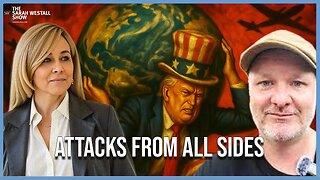Premium Only Content

The Illusion of Taxation: How the U.S. Government Truly Finances Itself
The financial framework of the United States is a complex web that relies on far more than taxation to sustain itself. Many Americans assume that the taxes they pay fund the government’s operations, but this view oversimplifies a much more intricate process. The reality is that the U.S. government primarily finances itself through the issuance of Treasury bonds and the Federal Reserve’s role in purchasing these bonds, effectively creating money. This system, while functional on the surface, raises deep concerns about sustainability and potential economic risk. Let’s dive into how this system operates, why taxes don’t directly fund the government, and the implications of this economic model.
1. The Treasury Bonds Mechanism: Funding Through Debt
At the heart of U.S. government funding is the sale of Treasury bonds, which are essentially IOUs that the government promises to pay back with interest over time. Rather than relying on tax revenue alone, the government issues these bonds to raise money for spending needs—everything from defense and healthcare to infrastructure projects. These bonds are bought by various entities, including foreign governments, private investors, and, most notably, the Federal Reserve.
When the U.S. Treasury issues bonds, it is essentially borrowing money from whoever buys them, with the promise to repay with interest. The reliance on debt issuance allows the government to spend well beyond what it collects in tax revenue, as it borrows from the future to finance present-day expenditures. This approach works only as long as there is confidence in the government’s ability to repay its debts and stability in the dollar’s value.
2. The Federal Reserve’s Role: Money Creation Through Bond Purchases
The Federal Reserve, the U.S. central bank, plays a unique role in this system. It is one of the largest buyers of Treasury bonds, effectively “printing” money to finance government operations. Here’s how it works:
When the Treasury issues bonds, the Federal Reserve buys a large portion of these bonds with funds it creates electronically. This is often called “money printing,” although it’s more accurately the creation of digital currency. The funds are created without any direct backing by tangible assets, and the bonds themselves act as the collateral for this newly created money. The Fed’s purchases increase the money supply, adding liquidity to the economy and keeping interest rates low to encourage borrowing and spending.
This arrangement creates a closed loop: the government issues debt, the Fed buys that debt by creating money, and this new money circulates within the economy. In essence, the Treasury and Fed operate within a self-sustaining bubble, where money is created to fund government operations, relying primarily on public trust and market confidence rather than direct revenue generation.
3. The Role of Taxes: Preserving an Illusion of Fiscal Responsibility
Given this system of debt and money creation, one might wonder why taxes are even necessary. After all, if the Fed can create money by purchasing bonds, why collect taxes at all?
Taxes serve multiple purposes beyond simply funding government operations:
• Illusion of Fiscal Responsibility: Taxation creates the impression that citizens are directly supporting government functions. This preserves public trust and confidence, reinforcing the belief that government spending is backed by real contributions rather than debt.
• Economic Control: Taxes help regulate the economy by redistributing wealth and managing inflation. High taxes can temper consumer spending, while tax cuts can stimulate economic activity.
• Social Cohesion: The tax system maintains a level of accountability between citizens and the government, reinforcing the idea that taxpayers have a stake in government operations.
Thus, while taxes do generate revenue, their primary purpose is more about controlling economic behavior and upholding public confidence than actually funding government spending.
4. The Sustainability Question: A System Built on Borrowed Time?
The reliance on debt and money creation poses significant risks. This financial system hinges on public confidence in the dollar, the government’s ability to repay its debts, and the Federal Reserve’s capability to control inflation and interest rates. However, should confidence waver, the consequences could be severe:
• Potential for Inflation: As the Fed increases the money supply by purchasing Treasury bonds, there’s a risk of inflation. While the Fed has managed inflation effectively for decades, continued money creation could eventually outpace economic growth, causing prices to rise. Hyperinflation, though unlikely, is a looming possibility if confidence is lost.
• Growing National Debt: The U.S. national debt has exceeded $30 trillion and continues to grow as the government relies on debt issuance to fund its spending. Interest payments alone consume a significant portion of the federal budget, reducing funds available for essential services.
• Economic Bubbles: As money flows into the economy, it often finds its way into asset markets like real estate and stocks, inflating prices. This can lead to economic bubbles, which pose risks to financial stability if they burst.
If this self-reinforcing cycle of debt and money creation continues without meaningful reform, the risk of a financial crisis grows. The “bubble” of debt-backed money has yet to burst, but the possibility remains a threat to both the U.S. economy and global financial stability.
5. Moving Forward: Potential Reforms and Economic Resilience
Addressing these systemic issues requires bold changes. Some potential reforms include:
• Monetary Policy Adjustments: The Federal Reserve could reevaluate its reliance on Treasury bond purchases as a primary funding mechanism for government spending. Alternative approaches, such as reducing debt issuance or increasing interest rates gradually, could help manage inflation and reduce dependency on debt.
• Deficit Reduction: Gradual reductions in government spending and fiscal discipline could help limit debt growth. Reducing the national debt, however, is politically challenging and would likely require bipartisan cooperation and difficult budget cuts.
• Public Awareness and Transparency: Educating the public on the realities of government financing and the role of taxes can foster a more informed citizenry, one that holds policymakers accountable for sustainable economic practices.
• Strengthening the Dollar: Maintaining the dollar’s stability on the global stage is crucial. Policies that bolster U.S. economic growth, encourage exports, and manage trade imbalances will strengthen the dollar’s role as the world’s reserve currency, preserving the current system’s stability.
Conclusion: The Illusion and Reality of Government Financing
The U.S. financial system is a complex network that relies heavily on debt, the Federal Reserve, and public confidence. Taxes, while vital for economic management, primarily serve as an illusion of fiscal responsibility rather than a direct funding source. This reliance on debt and money creation raises questions about the system’s sustainability and long-term risks. Without meaningful reform, the current system could face a reckoning, threatening both the U.S. economy and the global financial order.
Ultimately, understanding the true nature of government financing enables citizens to demand greater transparency and accountability. Only by addressing the structural weaknesses of this system can we create a more resilient and sustainable financial future.
-
 1:10
1:10
FragmentsOfTruth
2 days agoNO TWO SIBLINGS GROW UP IN THE SAME HOUSE
219 -
 LIVE
LIVE
Kim Iversen
1 hour agoIsrael DEMANDS X Remove Posts and X COMPLIES | Socialist Groceries Coming To A Store Near You!
1,143 watching -
 1:11:53
1:11:53
vivafrei
8 hours agoThe Great Replacement of American Truckers With Unskilled Foreign Labor - Live with Gord Magill
67.4K42 -
 LIVE
LIVE
Sarah Westall
1 hour agoEU Falling, United States Barely Hanging on - Strength and Courage Needed to Fight for Free Speech
244 watching -
 LIVE
LIVE
LFA TV
10 hours agoLFA TV ALL DAY STREAM - TUESDAY 8/19/25
1,392 watching -
 2:11:18
2:11:18
The Quartering
3 hours agoToday's Breaking News! Disgusting Grocery Shopping "Haul" Goes Viral, Las Vegas Collapse & More
68.8K26 -
 LIVE
LIVE
StoneMountain64
4 hours agoBest Extraction shooter is FINALLY on Console (+CoD Reveal Today)
280 watching -
 3:04:51
3:04:51
Due Dissidence
6 hours agoZelensky RETURNS To DC, HUGE Protests In Israel, Gal Gadot Blames Palestine For Flop, MSNBC Rebrands
14K14 -
 1:19:29
1:19:29
The HotSeat
2 hours ago🚨 Dems Swear Mail-In Voting Is “Secure”… Trump Says HELL NO 🚨
3.6K7 -
 LIVE
LIVE
Reidboyy
8 hours ago $0.55 earnedNEW FREE FPS OUT ON CONSOLE TODAY! (Delta Force = BF6 Jr.)
62 watching